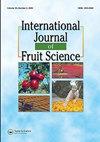蓝莓品种的细菌性枯萎病抗性
IF 2.5
3区 农林科学
Q2 HORTICULTURE
引用次数: 0
摘要
蓝莓的生产在美国和全球范围内迅速扩大。2016年,佛罗里达州的蓝莓生产中发现了细菌性枯萎病。由于植物的国际流动,这种疾病对生产构成重大风险。本项目的目的是评估蓝莓品种和栽培品种对佛罗里达州蓝莓生产中发现的三种遗传上不同的Ralstonia种群的抗性。本研究选用了19个牛痘栽培品种。植物选自野生、北方、南方、中灌木、矮灌木和兔眼品种。植物接种了三种遗传上不同的病原菌菌株,实验重复了三次。不同品种对青枯病的数量(多基因)抗性不同,其中兔眼品种的抗性最强。这些结果与在其他农艺作物中观察到的抗青枯病性相似。我们还观察到兔眼品种‘Ochlockonee’具有独特的定性(垂直)抗性。该病菌不能在植株组织中定植并引起病害。本文首次报道了蓝莓对茄枯病菌的定性抗性。多基因和垂直抗性都可以纳入蓝莓育种计划,以减轻细菌性枯萎病的潜在损失。本文章由计算机程序翻译,如有差异,请以英文原文为准。
Bacterial Wilt Resistance in Blueberry Species
ABSTRACT Blueberry production is expanding rapidly in the United States and globally. In 2016, bacterial wilt was discovered in Florida blueberry production. Because of the international movement of plants, this disease poses a significant risk to production. The purpose of this project was to evaluate the resistance of blueberry species and cultivars to the three genetically distinct populations of Ralstonia identified in Florida blueberry production. Nineteen cultivars/species of Vaccinium were used in this study. Plants were selected from wild, northern, southern, midbush, lowbush, and rabbiteye varieties. Plants were inoculated with three genetically distinct strains of the pathogen, and experiments were replicated three times. Varying levels of quantitative (multigenic) bacterial wilt resistance were observed among varieties tested, with rabbiteye cultivars being the most resistant. These results are similar to bacterial wilt resistance observed in other agronomic crops. We also observed a unique specific qualitative (vertical) resistance in the rabbiteye cultivar ´Ochlockonee’. The pathogen was unable to colonize plant tissue and cause disease on this cultivar. This is the first report of qualitative resistance to Ralstonia solanacearum in blueberry. Both the multigenic and vertical resistance can be incorporated into blueberry breeding programs to mitigate potential losses to bacterial wilt.
求助全文
通过发布文献求助,成功后即可免费获取论文全文。
去求助
来源期刊

International Journal of Fruit Science
Agricultural and Biological Sciences-Agronomy and Crop Science
CiteScore
6.40
自引率
0.00%
发文量
64
审稿时长
10 weeks
期刊介绍:
The International Journal of Fruit Science disseminates results of current research that are immediately applicable to the grower, extension agent, and educator in a useful, legitimate, and scientific format. The focus of the journal is on new technologies and innovative approaches to the management and marketing of all types of fruits. It provides practical and fundamental information necessary for the superior growth and quality of fruit crops.
This journal examines fruit growing from a wide range of aspects, including:
-genetics and breeding
-pruning and training
-entomology, plant pathology, and weed science
-physiology and cultural practices
-marketing and economics
-fruit production, harvesting, and postharvest
 求助内容:
求助内容: 应助结果提醒方式:
应助结果提醒方式:


